Classy, Classic & Couture – Tony Glenville



Dior
Paris was already gearing up towards the Olympic Games whilst Haute Couture was happening, indeed the date was a good week earlier than usual. How might the Olympics inspire fashion designers? Gold Silver & Bronze? Track pants and leotards, shorts, and vests. Maria Grazia Chiuri took a sophisticated across the centuries view of the influences and ranged her inspiration from Roman mosaics through ancient Sparta and onwards to the simplest modern active basics, and then mixed and layered them in a very ceremonial manner. As the models walked past it felt like the modernity of close to the body streamlining was being matched by soft classical fluidity to create a freshness, a healthy, almost open air feel to the pieces. With a colour palette which did indeed for the finale use a range of shimmering, very subtle metallics there was a lot of white, and some black, plus very discrete colours in embroideries. The house sensibly put some wonderful Savoir Faire films on YouTube to show closeups of the exquisitely refined work, which the petits mains had conjured up out of fabrics, beads, silken threads, and fragile fabrics to contrast with the clean lines and the simple lines of many of the pieces. A toga like quality to dresses and over layers, meant many looks wrapped and unwrapped or were tied with simple narrow graphic ties. As the collection processed around the huge tent erected in the garden of the Musee Rodin the purity and simplicity of the looks, and the sleek styling, contrasted with the vibrant thirty-two mosaics lining the walls by Faith Ringgold. Movement and colour in the décor threw into relief the stately parade we were watching. I thought of operas such as Bellini’s Norma with the praise of the moon or even Gluck with Alceste. There was a calm loveliness to the collection. At a time where there are loud voices in fashion, both from designers and those craving drama and novelty this was an oasis as opposed to the storm.
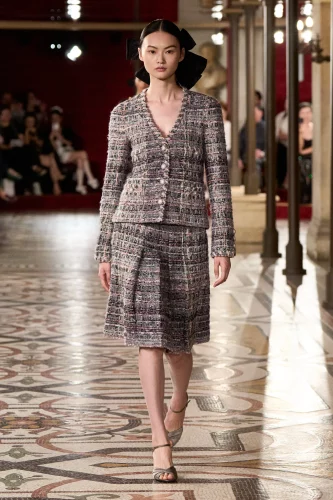
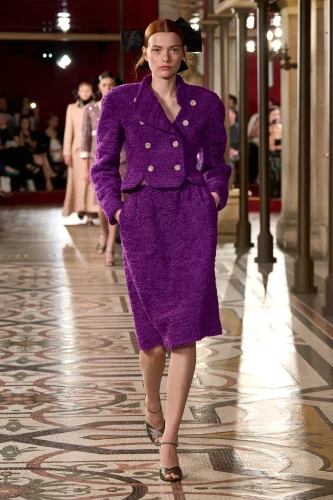

Chanel
After Chanel died the house engaged Philippe Guibourge to design the collections, and he created Chanel Pret a Porter. He and Karl Lagerfeld swapped places when Lagerfeld left Chloe to take over Chanel couture and Guibourge went to Chloe. A season later Karl Lagerfeld was also asked to take over Pret a Porter. Virginie Viard had been with Lagerfeld at Chloe and obviously she was at Chanel. Discreetly behind the scenes for many years she wasn’t like Gilles Dufour or Eric Wright who were both known. In the final year of Lagerfeld’s time at Chanel Viard became increasingly see and credited. Her ascension to take over the lead role seems natural. Her collections and her shows lacked Lagerfeld’s panache and her designs for the actual clothes didn’t excite many people. Especially for the Instagram generation flash and excitement is paramount. However, who knows if the search for a replacement for Viard, now taking place, was daunting, or the management teams wanted a “safe” pair of hand to transition the house? Her departure was finally swift and so this season’s haute couture collection was created by a studio team. Firstly, the choice of the Opera Garnier was a was not obvious, used by a fair number of designers over the years including, Dior, Stephane Rolland, and Schiaparelli it’s much more opulent and vintage in feel, and it’s much more intimate. The collection was beautifully thought through by the team and had a number of historical references to Gabrielle “Coco” Chanel’s signatures of course. It also had several hints of Lagerfeld’s contribution to the house, which was interesting, since in the final analysis the collection looked like several, different handwritings interpreting the Chanel oeuvre. The juxtapositions of shiny black and micro short against conservative tweed suits, the flourish of taffeta romanticism against neat twinkly cocktail looks was offering a broad range of options for clients but was not strongly coherent. There was perhaps more glitter and embroidery, and the was a slender approach to the classic silhouette. However, we have to say that this collection will get lost in the history of the house, much like the Bill Gayton time at Dior. A job very well done, but a pause in the history of the house. Now, the huge question remains, who will seize the creative reins at this important global fashion, fragrance, and beauty brand? Will, the subject was raised again and again, and again, during couture and the possibilities ranged wildly and widely.
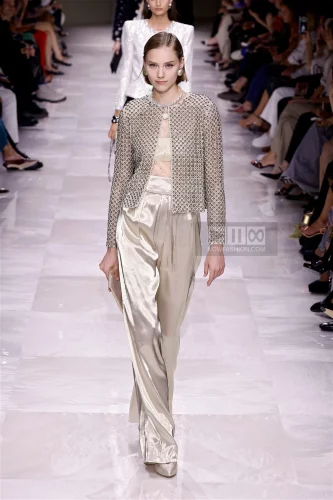


Armani Prive
Armani Prive was established in January 2005, so next year will be it’s twentieth anniversary. Mr Armani has always had a. Dry specific approach to these collections and the development from the made to measure side of Collezioni has had a smooth transition of the Armani signatures. Beautiful pieces, with truly breathtaking craft in the decoration and work, and a timeless elegance, have been its hallmarks. This season was truly the pinnacle of this approach with a largely monochrome collection of edited looks whose rigour never looked hard or dull, and whose grace and chic wasn’t just timeless but eternal. It was one hundred percent Giorgio Armani in its care, balance, empowerment, and discrete sexiness. These clothes give the wearer confidence and allure, and yet are not complex or challenging to wear. The pace and fluidity of the collection was lovely, and this makes it hard to pick out individual looks. There was golden cardigan beaded of transparencies with a simple top and trousers, fragile weightless tops and softly gathered skirts, the tops often like clouds or mist in their lightness. There were column dresses weighed down, again on transparent or sheer foundations with pearls, or golden beads sliding to the ground. Slivers of fabric and the slimmest of silhouettes wrapped around the models dissecting yet enhancing the body. it. Predominantly in black and white with shimmer and pearls and crystals and metallics, this wasn’t the Mr Armani of beige and neutrals we so famously associate with him. From any couturier this would be a standout collection, from Mr Armani, who turned 94 on July 11th it wasn’t a retrospective, or greatest hits revamped, it was a superb demonstration of why he remains a fashion force.
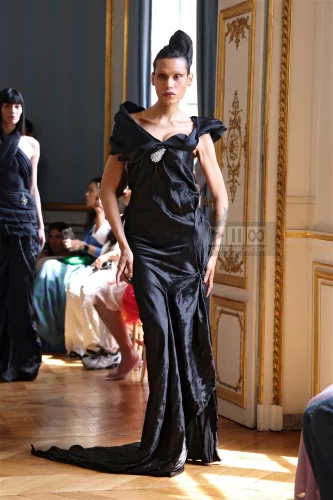

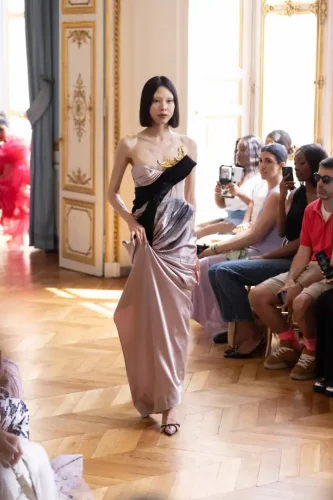
Peet Dullaert
I am sure the narrative I placed upon the designer Peet Dullaert’s collection is personal, but both last season at the Archives Nationale and this time at Hotel d’Evreux the mood for me was an Embassy, court or delegation dressed for an occasion. The pieces are wonderfully constructed but then also have a modernity and deconstruction element to them which makes them a personal statement and quirky. It’s not nostalgia or old fashioned romance, but there is a deeply romantic quality to the clothes through there hints of couture of the past revisited. Perhaps a trailing ribbon or a draped basque, a twisted diagonal drapery, or a jewel placed as though a royal decoration. A flourish of taffeta around the shoulders, a swoosh of fabric unfolding to allow for movement, a severe floor length coat dress in knobbly tweed or simply an evening dress swirl of fabric encircling the body. The balance between tuxedo details and tailoring, and then the soft the flou, much of it in black, offers options to the client. The use of a sharp seventeenth century yellow or a dusty bois de rose with black had the feeling of old portraits and reinforced my hints of the embassy ball in My Fair Lady and possibly the court of Transylvania. Monsieur Dullaert has an individual and special response to couture, and one Cecil Beaton would have drawn most beautifully.
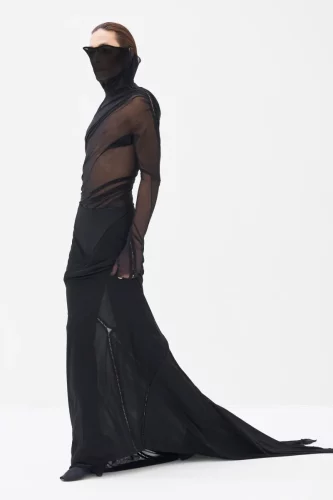


Jean-Paul Gaultier
It was, so I am reliably informed, Monsieur Gaultier’s own idea to invite a new designer every season to create a couture show using his archives, ateliers, and headquarters. Well, to be honest it never intrigued me, apart from Glenn Marten and Haider Ackerman. I confess I can’t even give you a complete list. So, when it was announced this time, it was to be Nicholas de Felice from Courreges I wasn’t that interested, except of course professionally I’d look and evaluate. I then realised he’s thirty-seven and is young in terms of his couture reference so it was exciting to see what he might do. It was superb. He pared back the house signatures, streamlined and cutaway, he sharply edited, all this to reveal his modern sharp view of the heritage of the house. He didn’t play it safe and rely on corsetry, matelot stripes and some tailoring, he created a collection with a linear modernity which did two things; elevated his own standing as a designer, and which also demonstrated that the essential essence of the work of Jean-Paul Gaultier remains relevant. If you watch the show you can see how De Felipe doesn’t try and copy or mirror the kind of story telling JPG was famous for, but the focus is on the clothes and a collection with a nod in some subtle form or the other giving the heritage of to the founder of the house an acknowledgment. I liked the entire collection and its aesthetic, I still don’t care whose next now, because I want De Felice to stay, but since he’s doing so very well at Courreges I doubt my wish will be granted.
His collection used elements of the house archive and Jean-Paul Gaultier’s approach but without turning too far away from the founder of the house he modernised it; he updated it, and he offered stunning clothes. There was a freshness that only Haider Ackerman has to my mind brought to the seasonal task of creating a collection. If you look at the pictures the collection is consistent and thought through from beginning to end without trying to reference too many elements. It’s clear that he should remain there, but since de Felice is already designing, and very successfully, Courrèges this is unlikely to happen.



Schiaparelli
I saw Daniel Roseberry’s first collection for Schiaparelli; indeed, I’ve seen every collection at the house since the relaunch with Christian Lacroix back in July 2013. There have been some extraordinarily strong designers and collections during these years but after sixteen years Behind the scenes at Thom Browne the surprise appointment of Mr Roseberry was interesting, and his step into the limelight was clearly something that suited him and the house. He’s incredibly special in that he can sketch, he can work in the atelier, he sees clothes in the round, and he respects the heritage of the house without either following it slavishly or just talking about it but not understanding it. He’s also articulate and great on communication on camera. How recreations from time to time are brilliant because he literally allows things to be “remade.” I’ve loved many looks and many pieces, but I felt this seasons was either marking time or just a less inspired moment after so much brilliant work. Don’t get me wrong, few people could have achieved this season’s collection, but the Charles James dress, the very Azzedine Alaia/Antonio Lopez inspired dress, the pink corset dress with shoe bra (Gaultier does Schiaparelli?) and the other pieces felt a bit like exercises rather than fresh or innovative. The huge skirts on several looks, the embellished sheath dresses and other elements were a bit “historic” for a modern collection. Perhaps too much looking back, too much time in the archives? It’s hard to know why it also didn’t feel like a collection, Mr Roseberry has always offered an avalanche of ideas, but this felt disparate in its intention. I look forward to next season when I’m sure he’ll be back on form.

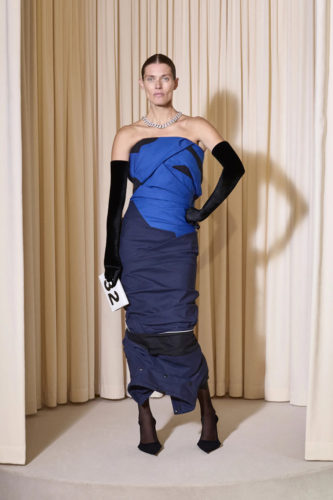

Balenciaga
I wasn’t at the show, but it’s fascinating how many opinions there are and diverse views on the work of the designer Demna. I’ve always found him a fascinating designer with one foot firmly planted in today and the street and the other respecting and ask the past. His ideas have always been clever and the launch of Vetements was an exciting challenger in fashion history back in exactly a decade ago. His contribution for fashion cannot be argued, but he is therefore also controversial, and his statements and his philosophies are divisive. This show felt as if he himself was divided. The street, up cycling, iconoclastic Demna, and the Demna of the very first Balenciaga, reawakening a sleeping house of couture. It always been a bit like this, but this season felt more exaggerated as if two separate collections had been forced to share the same catwalk. I also though how lumpy and try hard some of it was, the hanging sleeves at the back of the denim bustier, the metres of silk wound around the model tottering in, the dangling bits on the tee shirts dress. The dress made belts made me realise that the ghost of Martin Margiela and his original Artisanal collections hovered over much of the collection, the dress made of belts really hitting this home. It not bad, and it’s certainly not dull but as a designer this collection seemed unresolved and as couture, slightly studenty in its approach. Demna needs to review his next step with the house, and, although it’s unimportant, many of his fans on social media seem to be bored and unconvinced by this collection
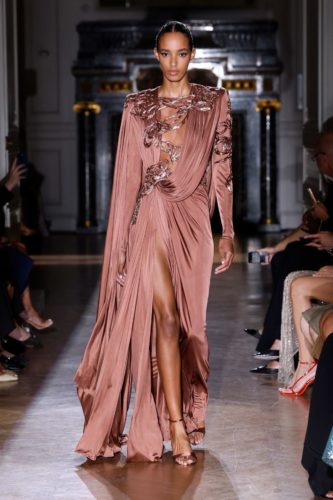


Zuhair Murad
With scarlet, prune, marron glacé, cherry, and a colour like rose from a child’s paint box, plus of course plenty of black and silver this was a beautiful Murad collection. It’s also featured to my mind more velvet than usual used as sliced across glittering embroidery, or as huge stoles dragging behind the models. Indeed, back views and exits received as much attention as front view and entrances, with jewelled loops across bare backs, trailing swathes of mousseline and billowing silver lame fluttering out of the rooms of the Hotel Salomon Rothschild. Drape played a key role in many of these back views, and throughout the collection, lacquer red velvet slashed and draped held by glittering encrustations, rose jersey draped and sweeping behind the model held by curlicues of diamond embroidery, or draped silk mousseline exquisite dress in soft blueberry in the heritage of the great Jean Desses, the king of drape. Indeed, the collection felt truly like a couture show, not in any way old fashioned but respecting the variety such a collection needs. Covered up crepe or micro short, barely there or modest, the collection respected coutures rules and yet looked and felt modern. It spoke of a designer with great skills, confidence, and his own personal signature. I am lucky enough to have been attending Zuhair Murad shows for many, many seasons, watching using his own aesthetic and signatures he modifies and subtly progresses forward each season. How he watches what his clients need and their changing lives and attitudes and, without tricks or losing his personal views on fashion, he takes them on a fresh journey. I thought this was an especially strong collection from a designer whose work perfectly balances the past, the present, and the future of couture glamour, especially since I was in Paris, perched on a tiny gilt chair under sparkling chandeliers in a Hôtel Particulier, the fantasy of couture made reality.
Tony Glenville
